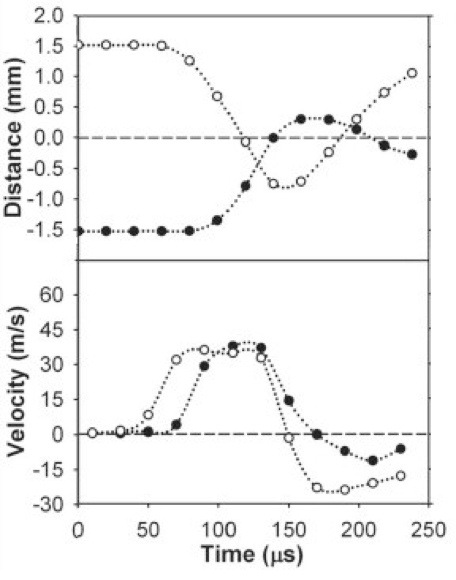4.1.2.P9
|
A remarkable species of ants known as “trap-jaw ants” have a pair of jaws (mandibles) that can open to 180o and quickly snap shut, either to attack prey or in self defense. As a defense mechanism, snapping its jaws shut on the ground sends the ant flying off backwards or up into the air, to a distance many times the ant’s length. The head of the ant with the jaws in the open and closed position are shown at the right. (You can see this in a YouTube video!)
|

Wikipedia, Odontomachus |
|
A group at Berkeley* took high-speed videos of the ants jumping. (The frame rate was one frame every 20 microseconds – 2 x 10-5 s – about 1000 times faster than an everyday video!) From these videos, they were able to extract the position and velocity of the snapping mandibles, as shown in the graphs at the right. These are the data for “unobstructed” mandibles – ones that snap closed but don’t hit anything. Let’s use these data to get an idea of the forces involved. For each part be sure to include a careful explanation of how you got your answers.
A. One mandible (the one represented by the open circles in the graphs) changes its speed from about 40 m/s (that is NOT a typo) to -30 m/s in about 40 μs (4 x 10-5 s). If the mass of the mandible is 130 μg (1.3 x 10-7 kg), find the momentum change of the mandible and the average force acting on it during that time.
*S. N. Patek et al., PNAS 103:34 (8/22/2006) 12787-12792.
|
 |
B. If the force from the two mandibles is exerted on an object in front of the ant, the ant will be thrown backward or upwards. If the mass of the ant is 12 mg (1.2 x 10-5 kg), with what speed will the ant be thrown backwards?
C. If in these graphs each mandible moves 2.0 mm while exerting its force on the ground about how high will the ant be thrown in the air? (Simplify the calculation by ignoring air resistance and assuming the ant is pushing straight down the entire time.)
Thanks to Steve Vogel for introducing me to trap-jaw ants!
Joe Redish 11/18/10
Comments (0)
You don't have permission to comment on this page.